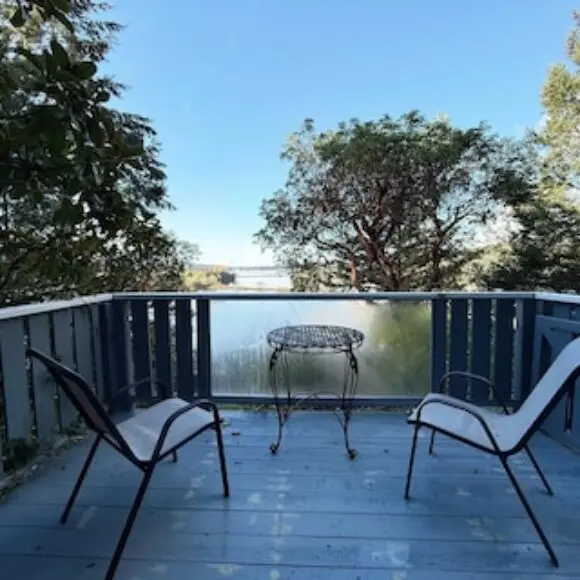Hotel Sterling Cove

Sterling Cove
Hotel Sterling Cove reviews
Looking for a great place to stay in Sooke? Book Sterling Cove; rated and is available from CAD $ 118. Sterling Cove is conveniently located near ferry terminals, and can be booked directly with Trivago.
📍 Address Sterling Cove
5301 Sooke Road, V9Z 0E8, Sooke, Canada
FAQ
Are there any food services available on the ferry Vancouver route from Salt Spring Island (Long Harbour) to Tsawwassen?
Yes, the ferry Vancouver route from Salt Spring Island (Long Harbour) to Tsawwassen typically offers various food service options. To explore the specific food services available, please visit the Long Harbour to Tsawwassen food services page. This resource provides information on onboard cafes, restaurants, and snack bars, ensuring you can enjoy a meal or snack during your journey.
Are there accessible facilities at the Buckley Bay ferry Vancouver terminal?
The Buckley Bay ferry Vancouver terminal is committed to providing accessible facilities for all passengers. This includes features such as accessible parking, ramps, and restrooms. To ensure a comfortable and seamless experience, it’s recommended to review the specific Buckley Bay terminal accessibility details before your trip. The terminal staff is also available to assist passengers with any specific needs or inquiries.
Ferry Vancouver
Connecting transportation from ferry terminals includes public transit, rental cars, taxis, and ride-sharing services. Victoria’s Swartz Bay terminal connects to downtown Victoria via public bus service. Nanaimo terminals provide access to Island-wide transportation networks for exploring Vancouver Island’s diverse attractions and natural areas.
Ferry travel tips for first-time visitors include arriving early, bringing layers for changing weather conditions, and planning ground transportation in advance. Understanding terminal layouts and boarding procedures reduces travel stress. Experienced ferry travelers recommend booking accommodations on Vancouver Island in advance, especially during peak season periods.
Cargo and freight services operate alongside passenger ferries, supporting Vancouver Island’s economy and supply chains. Commercial vehicles transport everything from fresh produce to building materials. This integrated transportation system maintains Vancouver Island’s connection to mainland markets and services.
Environmental initiatives by ferry operators focus on reducing emissions and protecting the sensitive marine ecosystem of the Salish Sea. Modern vessels incorporate fuel-efficient technologies and waste reduction programs. Passengers can contribute to environmental protection by following onboard recycling and conservation guidelines.
Ferry services to Vancouver Island provide the essential connection between mainland British Columbia and one of Canada’s most beautiful destinations. BC Ferries operates multiple routes linking the mainland to various ports on Vancouver Island, offering travelers spectacular scenic journeys across the Salish Sea. These ferry crossings are not just transportation but memorable experiences showcasing the stunning Pacific Northwest coastline.
Multi-day Vancouver Island itineraries often begin with ferry travel from the mainland, allowing tourists to explore the island’s diverse regions. Popular destinations include Victoria’s Inner Harbour, Tofino’s surf beaches, and the wine regions of the Cowichan Valley. Ferry connections enable comprehensive island exploration combining urban and wilderness experiences.
Ferry reservations are highly recommended, especially during peak summer months and holiday periods when demand significantly exceeds capacity. Advance booking ensures guaranteed passage and reduces waiting times at terminals. Walk-on passengers and cyclists typically have more flexibility, while vehicle spaces often sell out during busy travel periods.
Tourist information centers at major ferry terminals provide maps, brochures, and local expertise for Vancouver Island travel planning. Knowledgeable staff offer recommendations for accommodations, attractions, and activities. These resources help first-time visitors maximize their Vancouver Island experience.
Group travel accommodations are available for tour operators, schools, and large organizations visiting Vancouver Island. Group rates and special arrangements can be coordinated for enhanced travel experiences. Motor coach tours frequently utilize ferry services as part of Pacific Northwest touring packages.
Vancouver Island ferry terminals feature modern amenities including restaurants, gift shops, and comfortable waiting areas. Tsawwassen and Swartz Bay terminals offer extensive facilities with multiple dining options, retail stores, and children’s play areas. Terminal locations provide convenient access to ground transportation, rental cars, and connecting bus services.




